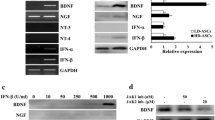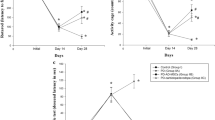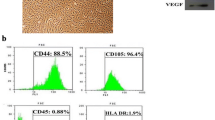Abstract
Adult human adipose-derived mesenchymal stem cells (MSC) have been reported to induce neuroprotective effects in models for Parkinson´s disease (PD). However, these effects strongly depend on the most optimal application of the transplant. In the present study we compared monolayer-cultured (aMSC) and spheroid (sMSC) MSC following transplantation into the substantia nigra (SN) of 6-OHDA lesioned rats regarding effects on the local microenvironment, degeneration of dopaminergic neurons, neurogenesis in the hippocampal DG as well as motor and memory function in the 6-OHDA-rat model for PD. aMSC transplantation significantly increased tyrosine hydroxylase (TH) and brain-derived neurotrophic factor (BDNF) levels in the SN, increased the levels of the glial fibrillary acidic protein (GFAP) and improved motor functions compared to untreated and sMSC treated animals. In contrast, sMSC grafting induced an increased local microgliosis, decreased TH levels in the SN and reduced numbers of newly generated cells in the dentate gyrus (DG) without yet affecting hippocampal learning and memory function. We conclude that the neuroprotective potential of adipose-derived MSC in the rat model of PD crucially depends on the applied cellular phenotype.













Similar content being viewed by others
References
Hornykiewicz, O. (1982). Imbalance of brain monoamines and clinical disorders. Progress in Brain Research, 55, 419–429.
Ehringer, H., & Hornykiewicz, O. (1960). Distribution of noradrenaline and dopamine (3-hydroxytyramine) in the human brain and their behavior in diseases of the extrapyramidal system. Klinische Wochenschrift, 38, 1236–1239.
Ungerstedt, U. (1968). 6-Hydroxy-dopamine induced degeneration of central monoamine neurons. European Journal of Pharmacology, 5, 107–110.
Schwarting, R. K., & Huston, J. P. (1996). The unilateral 6-hydroxydopamine lesion model in behavioral brain research. Analysis of functional deficits, recovery and treatments. Progress in Neurobiology, 50, 275–331.
Weintraub, D., Comella, C. L., & Horn, S. (2008). Parkinson’s disease–part 3: neuropsychiatric symptoms. The American Journal of Managed Care, 14, S59–S69.
Chaudhuri, K. R., Healy, D. G., & Schapira, A. H. (2006). Non-motor symptoms of Parkinson’s disease: diagnosis and management. Lancet Neurology, 5, 235–245.
Suzuki, K., Okada, K., Wakuda, T., et al. (2010). Destruction of dopaminergic neurons in the midbrain by 6-hydroxydopamine decreases hippocampal cell proliferation in rats: reversal by fluoxetine. PLoS ONE, 5, e9260.
Baddeley, A. (1992). Working memory. Science, 255, 556–559.
Perez, V., Marin, C., Rubio, A., Aguilar, E., Barbanoj, M., & Kulisevsky, J. (2009). Effect of the additional noradrenergic neurodegeneration to 6-OHDA-lesioned rats in levodopa-induced dyskinesias and in cognitive disturbances. Journal of Neural Transmission, 116, 1257–1266.
Zweifel, L. S., Argilli, E., Bonci, A., & Palmiter, R. D. (2008). Role of NMDA receptors in dopamine neurons for plasticity and addictive behaviors. Neuron, 59, 486–496.
Zweifel, L. S., Parker, J. G., Lobb, C. J., et al. (2009). Disruption of NMDAR-dependent burst firing by dopamine neurons provides selective assessment of phasic dopamine-dependent behavior. Proceedings of the National Academy of Sciences of the United States of America, 106, 7281–7288.
Hamilton, T. J., Wheatley, B. M., Sinclair, D. B., Bachmann, M., Larkum, M. E., & Colmers, W. F. (2010). Dopamine modulates synaptic plasticity in dendrites of rat and human dentate granule cells. Proceedings of the National Academy of Sciences of the United States of America, 107, 18185–18190.
Lennington, J. B., Pope, S., Goodheart, A. E., et al. (2011). Midbrain dopamine neurons associated with reward processing innervate the neurogenic subventricular zone. The Journal of neuroscience : the official journal of the Society for Neuroscience, 31, 13078–13087.
Yahr, M. D., Duvoisin, R. C., Schear, M. J., Barrett, R. E., & Hoehn, M. M. (1969). Treatment of parkinsonism with levodopa. Archives of Neurology, 21, 343–354.
Lattanzi, W., Geloso, M.C., Saulnier, N., et al. (2011). Neurotrophic features of human adipose tissue-derived stromal cells: in vitro and in vivo studies. Journal of biomedicine & biotechnology, 2011, 468705.
Kang, S. K., Shin, M. J., Jung, J. S., Kim, Y. G., & Kim, C. H. (2006). Autologous adipose tissue-derived stromal cells for treatment of spinal cord injury. Stem Cells and Development, 15, 583–594.
Chi, G. F., Kim, M. R., Kim, D. W., Jiang, M. H., & Son, Y. (2010). Schwann cells differentiated from spheroid-forming cells of rat subcutaneous fat tissue myelinate axons in the spinal cord injury. Experimental Neurology, 222, 304–317.
Zhou, Y., Sun, M., Li, H., et al. (2013). Recovery of behavioral symptoms in hemi-parkinsonian rhesus monkeys through combined gene and stem cell therapy. Cytotherapy.
Kim, J. M., Lee, S. T., Chu, K., et al. (2007). Systemic transplantation of human adipose stem cells attenuated cerebral inflammation and degeneration in a hemorrhagic stroke model. Brain Research, 1183, 43–50.
Kulikov, A. V., Stepanova, M. S., Stvolinsky, S. L., et al. (2008). Application of multipotent mesenchymal stromal cells from human adipose tissue for compensation of neurological deficiency induced by 3-nitropropionic Acid in rats. Bulletin of Experimental Biology and Medicine, 145, 514–519.
Anghileri, E., Marconi, S., Pignatelli, A., et al. (2008). Neuronal differentiation potential of human adipose-derived mesenchymal stem cells. Stem Cells and Development, 17, 909–916.
Ashjian, P. H., Elbarbary, A. S., Edmonds, B., et al. (2003). In vitro differentiation of human processed lipoaspirate cells into early neural progenitors. Plastic and Reconstructive Surgery, 111, 1922–1931.
Cardozo, A., Ielpi, M., Gomez, D., & Argibay, P. (2010). Differential expression of Shh and BMP signaling in the potential conversion of human adipose tissue stem cells into neuron-like cells in vitro. Gene Expression, 14, 307–319.
Dhar, S., Yoon, E. S., Kachgal, S., & Evans, G. R. (2007). Long-term maintenance of neuronally differentiated human adipose tissue-derived stem cells. Tissue Engineering, 13, 2625–2632.
Jang, S., Cho, H. H., Cho, Y. B., Park, J. S., & Jeong, H. S. (2010). Functional neural differentiation of human adipose tissue-derived stem cells using bFGF and forskolin. BMC Cell Biology, 11, 25.
Safford, K. M., Hicok, K. C., Safford, S. D., et al. (2002). Neurogenic differentiation of murine and human adipose-derived stromal cells. Biochemical and Biophysical Research Communications, 294, 371–379.
Baglioni, S., Francalanci, M., Squecco, R., et al. (2009). Characterization of human adult stem-cell populations isolated from visceral and subcutaneous adipose tissue. FASEB journal: official publication of the Federation of American Societies for Experimental Biology, 23, 3494–3505.
Miller, R. H., Bai, L., Lennon, D. P., & Caplan, A. I. (2010). The potential of mesenchymal stem cells for neural repair. Discovery Medicine, 9, 236–242.
Orlacchio, A., Bernardi, G., & Martino, S. (2010). Stem cells and neurological diseases. Discovery Medicine, 9, 546–553.
Wei, X., Zhao, L., Zhong, J., et al. (2009). Adipose stromal cells-secreted neuroprotective media against neuronal apoptosis. Neuroscience letters, 462, 76–79.
Zhang, H. T., Liu, Z. L., Yao, X. Q., Yang, Z. J., & Xu, R. X. (2012). Neural differentiation ability of mesenchymal stromal cells from bone marrow and adipose tissue: a comparative study. Cytotherapy, 14, 1203–1214.
Reid, A. J., Sun, M., Wiberg, M., Downes, S., Terenghi, G., & Kingham, P. J. (2011). Nerve repair with adipose-derived stem cells protects dorsal root ganglia neurons from apoptosis. Neuroscience, 199, 515–522.
Allen, S. J., Watson, J. J., Shoemark, D. K., Barua, N. U., & Patel, N. K. (2013). GDNF, NGF and BDNF as therapeutic options for neurodegeneration. Pharmacology & Therapeutics, 138, 155–175.
Hellmann, M. A., Panet, H., Barhum, Y., Melamed, E., & Offen, D. (2006). Increased survival and migration of engrafted mesenchymal bone marrow stem cells in 6-hydroxydopamine-lesioned rodents. Neuroscience Letters, 395, 124–128.
Bouchez, G., Sensebe, L., Vourc’h, P., et al. (2008). Partial recovery of dopaminergic pathway after graft of adult mesenchymal stem cells in a rat model of Parkinson’s disease. Neurochemistry International, 52, 1332–1342.
Venkataramana, N. K., Kumar, S. K., Balaraju, S., et al. (2010). Open-labeled study of unilateral autologous bone-marrow-derived mesenchymal stem cell transplantation in Parkinson’s disease. Translational research: the journal of laboratory and clinical medicine, 155, 62–70.
Bartosh, T. J., Ylostalo, J. H., Mohammadipoor, A., et al. (2010). Aggregation of human mesenchymal stromal cells (MSCs) into 3D spheroids enhances their antiinflammatory properties. Proceedings of the National Academy of Sciences of the United States of America, 107, 13724–13729.
Cheng, N. C., Wang, S., & Young, T. H. (2012). The influence of spheroid formation of human adipose-derived stem cells on chitosan films on stemness and differentiation capabilities. Biomaterials, 33, 1748–1758.
Suon, S., Yang, M., & Iacovitti, L. (2006). Adult human bone marrow stromal spheres express neuronal traits in vitro and in a rat model of Parkinson’s disease. Brain Research, 1106, 46–51.
Wang, W., Itaka, K., Ohba, S., et al. (2009). 3D spheroid culture system on micropatterned substrates for improved differentiation efficiency of multipotent mesenchymal stem cells. Biomaterials, 30, 2705–2715.
Schwerk, A., Altschüler, J., Roch, et al. (2013). (in press). Human adipose-derived mesenchymal stem cells induce subventricular neurogenesis and transdifferentiate into endothelial cells in the 6-hydroxydopamine rat model for Parkinson’s disease. PLoS One.
Gundersen, H. J. (1986). Stereology of arbitrary particles. A review of unbiased number and size estimators and the presentation of some new ones, in memory of William R. Thompson. Journal of Microscopy, 143, 3–45.
West, M. J., Slomianka, L., & Gundersen, H. J. (1991). Unbiased stereological estimation of the total number of neurons in thesubdivisions of the rat hippocampus using the optical fractionator. The Anatomical Record, 231, 482–497.
Gundersen, H. J., Jensen, E. B., Kieu, K., & Nielsen, J. (1999). The efficiency of systematic sampling in stereology–reconsidered. Journal of Microscopy, 193, 199–211.
Winter, C., Djodari-Irani, A., Sohr, R., et al. (2009). Prenatal immune activation leads to multiple changes in basal neurotransmitter levels in the adult brain: implications for brain disorders of neurodevelopmental origin such as schizophrenia. The international journal of neuropsychopharmacology/official scientific journal of the Collegium Internationale Neuropsychopharmacologicum, 12, 513–524.
Bustin, S. A. (2000). Absolute quantification of mRNA using real-time reverse transcription polymerase chain reaction assays. Journal of Molecular Endocrinology, 25, 169–193.
Bustin, S. A. (2002). Quantification of mRNA using real-time reverse transcription PCR (RT-PCR): trends and problems. Journal of Molecular Endocrinology, 29, 23–39.
Pfaffl, M. W. (2001). A new mathematical model for relative quantification in real-time RT-PCR. Nucleic Acids Research, 29, e45.
Livak, K. J., & Schmittgen, T. D. (2001). Analysis of relative gene expression data using real-time quantitative PCR and the 2(−delta delta C(T)) method. Methods, 25, 402–408.
Zavan, B., Vindigni, V., Gardin, C., et al. (2010). Neural potential of adipose stem cells. Discovery Medicine, 10, 37–43.
Coquery, N., Blesch, A., Stroh, A., et al. (2012). Intrahippocampal transplantation of mesenchymal stromal cells promotes neuroplasticity. Cytotherapy, 14, 1041–1053.
Snyder, B. R., Chiu, A. M., Prockop, D. J., & Chan, A. W. (2010). Human multipotent stromal cells (MSCs) increase neurogenesis and decrease atrophy of the striatum in a transgenic mouse model for Huntington’s disease. PLoS ONE, 5, e9347.
Hyman, C., Hofer, M., Barde, Y. A., et al. (1991). BDNF is a neurotrophic factor for dopaminergic neurons of the substantia nigra. Nature, 350, 230–232.
Levivier, M., Przedborski, S., Bencsics, C., & Kang, U. J. (1995). Intrastriatal implantation of fibroblasts genetically engineered to produce brain-derived neurotrophic factor prevents degeneration of dopaminergic neurons in a rat model of Parkinson’s disease. The Journal of neuroscience : the official journal of the Society for Neuroscience, 15, 7810–7820.
Sofroniew, M. V. (2009). Molecular dissection of reactive astrogliosis and glial scar formation. Trends in Neurosciences, 32, 638–647.
Sofroniew, M. V., & Vinters, H. V. (2010). Astrocytes: biology and pathology. Acta Neuropathologica, 119, 7–35.
Fernandez-Fernandez, S., Almeida, A., & Bolanos, J. P. (2012). Antioxidant and bioenergetic coupling between neurons and astrocytes. The Biochemical Journal, 443, 3–11.
Makar, T. K., Nedergaard, M., Preuss, A., Gelbard, A. S., Perumal, A., & Scooper, A. J. (1994). Vitamin E, ascorbate, glutathione, glutathione disulfide, and enzymes of glutathione metabolism in cultures of chick astrocytes and neurons: evidence that astrocytes play an important role in antioxidative processes in the brain. Journal of Neurochemistry, 62, 45–53.
Calkins, M. J., Johnson, D. A., Townsend, J. A., et al. (2009). The Nrf2/ARE pathway as a potential therapeutic target in neurodegenerative disease. Antioxidants & Redox Signaling, 11, 497–508.
Jakel, R. J., Kern, J. T., Johnson, D. A., & Johnson, J. A. (2005). Induction of the protective antioxidant response element pathway by 6-hydroxydopamine in vivo and in vitro. Toxicological sciences : an official journal of the Society of Toxicology, 87, 176–186.
Jakel, R. J., Townsend, J. A., Kraft, A. D., & Johnson, J. A. (2007). Nrf2-mediated protection against 6-hydroxydopamine. Brain Research, 1144, 192–201.
Burton, N. C., Kensler, T. W., & Guilarte, T. R. (2006). In vivo modulation of the Parkinsonian phenotype by Nrf2. Neurotoxicology, 27, 1094–1100.
Doetsch, F. (2003). The glial identity of neural stem cells. Nature Neuroscience, 6, 1127–1134.
Garcia, A. D., Doan, N. B., Imura, T., Bush, T. G., & Sofroniew, M. V. (2004). GFAP-expressing progenitors are the principal source of constitutive neurogenesis in adult mouse forebrain. Nature Neuroscience, 7, 1233–1241.
Steiner, B., Klempin, F., Wang, L., Kott, M., Kettenmann, H., & Kempermann, G. (2006). Type-2 cells as link between glial and neuronal lineage in adult hippocampal neurogenesis. Glia, 54, 805–814.
Kronenberg, G., Reuter, K., Steiner, B., et al. (2003). Subpopulations of proliferating cells of the adult hippocampus respond differently to physiologic neurogenic stimuli. The Journal of Comparative Neurology, 467, 455–463.
Kempermann, G., Jessberger, S., Steiner, B., & Kronenberg, G. (2004). Milestones of neuronal development in the adult hippocampus. Trends in Neurosciences, 27, 447–452.
Hanisch, U. K. (2002). Microglia as a source and target of cytokines. Glia, 40, 140–155.
Little, A. R., & O’Callagha, J. P. (2001). Astrogliosis in the adult and developing CNS: is there a role for proinflammatory cytokines? Neurotoxicology, 22, 607–618.
Akiyama, H., & Mcgeer, P. L. (1989). Microglial response to 6-hydroxydopamine-induced substantia nigra lesions. Brain Research, 489, 247–253.
Marinova-Mutafchieva, L., Sadeghian, M., Broom, L., Davis, J. B., Medhurst, A. D., & Dexter, D. T. (2009). Relationship between microglial activation and dopaminergic neuronal loss in the substantia nigra: a time course study in a 6-hydroxydopamine model of Parkinson’s disease. Journal of Neurochemistry, 110, 966–975.
Wu, D. C., Jackson-Lewis, V., Vila, M., et al. Blockade of microglial activation is neuroprotective in the 1-methyl-4-phenyl-1,2,3,6-tetrahydropyridine mouse model of Parkinson disease. The Journal of neuroscience : the official journal of the Society for Neuroscience, 22, 1763–71.
Gao, H. M., Liu, B., Zhang, W., & Hong, J. S. (2003). Critical role of microglial NADPH oxidase-derived free radicals in the in vitro MPTP model of Parkinson’s disease. FASEB journal: official publication of the Federation of American Societies for Experimental Biology, 17, 1954–1956.
Kim, Y. S., & Oh, T. H. (2006). Microglia, major player in the brain inflammation: their roles in the pathogenesis of Parkinson’s disease. Experimental & Molecular Medicine, 38, 333–347.
Baker, S. A., Baker, K. A., & Hagg, T. (2004). Dopaminergic nigrostriatal projections regulate neural precursor proliferation in the adult mouse subventricular zone. The European Journal of Neuroscience, 20, 575–579.
Freundlieb, N., Francois, C., Tande, D., Oertel, W. H., Hirsch, E. C., & Hoglinger, G. U. (2006). Dopaminergic substantia nigra neurons project topographically organized to the subventricular zone and stimulate precursor cell proliferation in aged primates. The Journal of neuroscience: the official journal of the Society for Neuroscience, 26, 2321–2325.
Winner, B., Geyer, M., Couillard-Despres, S., et al. (2006). Striatal deafferentation increases dopaminergic neurogenesis in the adult olfactory bulb. Experimental Neurology, 197, 113–121.
Borta, A., & Hoglinger, G. U. (2007). Dopamine and adult neurogenesis. Journal of Neurochemistry, 100, 587–595.
Coronas, V., Bantubungi, K., Fombonne, J., Krantic, S., Schiffmann, S. N., & Roger, M. (2004). Dopamine D3 receptor stimulation promotes the proliferation of cells derived from the post-natal subventricular zone. Journal of Neurochemistry, 91, 1292–1301.
Hoglinger, G. U., Rizk, P., Muriel, M. P., et al. (2004). Dopamine depletion impairs precursor cell proliferation in Parkinson disease. Nature Neuroscience, 7, 726–735.
Klaissle, P., Lesemann, A., Huehnchen, P., Hermann, A., Storch, A., & Steiner, B. (2012). Physical activity and environmental enrichment regulate the generation of neural precursors in the adult mouse substantia nigra in a dopamine-dependent manner. BMC Neuroscience, 13, 132.
Steiner, B., Winter, C., Hosman, K., et al. (2006). Enriched environment induces cellular plasticity in the adult substantia nigra and improves motor behavior function in the 6-OHDA rat model of Parkinson’s disease. Experimental Neurology, 199, 291–300.
Shors, T. J., Townsend, D. A., Zhao, M., Kozorovitskiy, Y., & Gould, E. (2002). Neurogenesis may relate to some but not all types of hippocampal-dependent learning. Hippocampus, 12, 578–584.
Alexander, G. E., & Crutcher, M. D. (1990). Functional architecture of basal ganglia circuits: neural substrates of parallel processing. Trends in Neurosciences, 13, 266–271.
Alexander, G. E., Delong, M. R., & Strick, P. L. (1986). Parallel organization of functionally segregated circuits linking basal ganglia and cortex. Annual Review of Neuroscience, 9, 357–381.
Bartosh T.J. 1, Ylostalo J. H. (2014). Preparation of anti-inflammatory mesenchymal stem/precursor cells (MSCs) through sphere formation using hanging-drop culture technique. Curr Protoc Stem Cell Biol 28:Unit 2B.6
Frangioni, J. V., & Hajjar, R. J. (2004). In vivo tracking of stem cells for clinical trials in cardiovascular disease. Circulation, 110(21), 3378–3383.
Coquery, N., Blesch, A., Stroh, A., Fernandez-Klett, F., Klein, J., Winter, C., & Priller, J. (2012). Intrahippocampal transplantation of mesenchymal stromal cells promotes neuroplasticity. Cytotherapy, 14(9), 1041–1053.
Acknowledgments
The authors thank Renate Winter for excellent technical assistance. The study was funded by the EFRE grant of the Investitionsbank Berlin to BS.
Disclosure of Potential Conflicts of Interest
No potential conflicts of interest.
Author information
Authors and Affiliations
Corresponding author
Rights and permissions
About this article
Cite this article
Berg, J., Roch, M., Altschüler, J. et al. Human adipose-Derived Mesenchymal Stem Cells Improve Motor Functions and are Neuroprotective in the 6-Hydroxydopamine-Rat Model for Parkinson’s Disease when Cultured in Monolayer Cultures but Suppress Hippocampal Neurogenesis and Hippocampal Memory Function when Cultured in Spheroids. Stem Cell Rev and Rep 11, 133–149 (2015). https://doi.org/10.1007/s12015-014-9551-y
Published:
Issue Date:
DOI: https://doi.org/10.1007/s12015-014-9551-y




